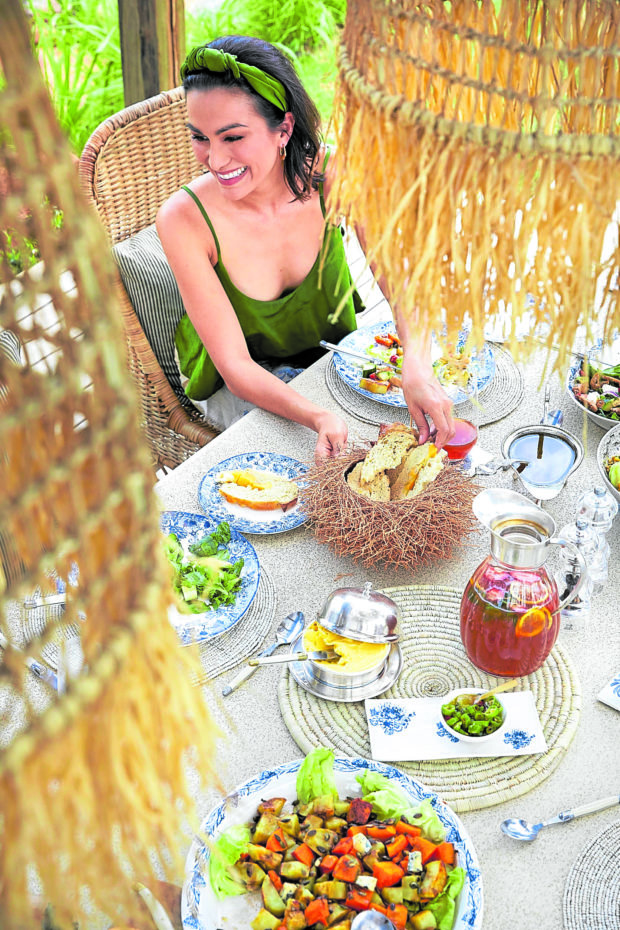Multihyphenate creative Stephanie Kienle Gonzalez adds another feather in her cap. This young managing director of Philux furniture company, TV host, style icon, taste arbiter, cover girl and marketer has authored a book, published by Rizzoli International, the famous purveyor of aspirational design titles.
Like many coffee-table books on interior decorators, “Embracing Natural Design: Inspired Living” is an expression of the author’s decor approach.
Frequently asked to describe her style, Gonzalez writes that it’s evolving as she encounters new artists and artisans who move her. She has a knack for layering or creating the interior character through contrasting styles, periods and textures.
The pictures of her residences—a condominium in Metro Manila and a safari lodge in a nature reserve in South Africa—reveal her taste for different cultures, objects with character, spaces filled with nature and light, streamlined furniture in wood and tactile surfaces.
“I wanted to show the contrast between city living and a rustic sanctuary but with the common thread of natural design that runs through both homes,” said Gonzalez.
Sense of place
She acknowledged the apartment’s design team—architect Alfred Wieneke, interior designer Isabel Lozano and architectural lighting designers Nikki Tayag and Mark Wilson—who created intimacy by using light to enhance architectural features. Gonzalez turns the city home into an oasis by filling it up with tropical plants and contemporary paintings by Filipino masters and South African artists.
The stylish bedroom for her daughters and the prominent display of their artworks make the condo child-friendly.

Asked how she creates a sense of place, she cites the infusion of local elements and underscores that natural design highlights the diversity of homegrown materials.
“I will have a bulul standing on Mactan travertine, a repurposed antique chair found in a small shop in Baguio; Filipino textile and objets d’art. This antique jar with branches, excavated in Mindanao, makes a statement piece at the foyer. I have hand-carved wooden frames under the staircase where I put my kids’ artworks. There are furniture from Philux, which I partially designed and a rattan commode from E. Murio. On my terrace are Philux chairs with woven details on the backs and an abaca outdoor rug,” she described.
“Even if I like things to be neat and orderly, you will find slime on the couch, hand prints on glass, and toys under the sofa. That’s part of our lives. These are little things that bring me joy.”
Soulful spaces
The Modumela House (named after the trees on the site), a four-bedroom lodge in the Lapalala nature reserve, looks as if it belonged to the South African wilderness. The architect, Julia Williams, specializes in low-impact, energy-saving homes and celebrates local slate and reed.
Interior designer Yvonne O’Brien produced a luxurious safari lodge look while maintaining the indigenous simplicity and highlighting sustainable materials. Boldly printed African textiles, modern and tribal art and European pieces complement the woven furniture from the Philippines.
“I talk a lot about meaningful pieces—sentimental objects— that bring soul to a place. I talk about color and how art and greenery bring life to the design,” she explained.
The book shares how nature blends with indoor and outdoor entertainment. “It’s not just showcasing the home. How do you want life in the home?” said Gonzalez.
To lend more substance, a chapter highlights international personalities who have either inspired her or who have collaborated with Philux. Bahamas-based British aristocrat and interior designer India Hicks (whose books were likewise published by Rizzoli) wrote the foreword. Gonzalez said Hicks’ style resonated with her—mixing relaxed Caribbean culture with British decorum, impressive tablescapes, the occasional mayhem in the kitchen, collections and creating a refuge at home.
She looks up to celebrity interior designer Nate Berkus and his business partner Lauren Gordon, proponents of collecting unique objects and layering.
Gonzalez also profiles the Modumela team—Williams and O’Brien and landscaper Tim Steyn, known for his visual dialogues between the garden and the house. Then there are Canadian architect Elora Hardy and her sinuous bamboo homes in Bali; American interior designer Hadley Wiggins-Mirin who balances nonchalant decor while highlighting crafts, and South African artist Lionel Smit whose powerful portraits explore his country’s identity.
Among the local talents, the book presents French-Filipina textile artist Olivia D’Aboville, known for sustainable art and material experimentation; designer Bea Valdes and her sister Marga, who champion Filipino handwork; furniture designer Kenneth Cobonpue whose playful designs marry local materials with industrial strength. Business leader Fernando Zobel de Ayala is cited for collecting art that should resonate with the owner.
“They have a strong sense of purpose behind their design and put soul into their spaces,” said Gonzalez.
Overload
Before the pandemic, Gonzalez compiled her photographs of the two homes, her notes and the listing of creatives and collaborators. She went for the big time as she sent her draft to an editor from Rizzoli. The editor responded that publisher Charles Miers was interested.
Gonzalez is lucky to have New York-based editor Sandy Gilbert who guided her in writing an informative text. Leaving tips on scale, surface finishes and layout to the pros, Gonzalez instead reflects on her decor journey, born out of a natural flair for putting things together.
In contrast, the styling of the Modumela house shows judiciously composed furniture and accessories that are balanced with each other. The owners’ collections are stored in vintage cabinets. The images show how natural lighting produces airy and warm spaces. Photographer Elsa Young brings out the sensual appeal of the stones and other natural textures.
Gonzalez underscored that “Embracing Natural Design” is her first foray into writing a book. “A beautiful home doesn’t necessarily have to be perfect. It should be cozy and filled with meaningful objects. While promoting craftsmanship, the book gives a gentle nudge to living a sustainable lifestyle that supports conscious design.” —CONTRIBUTED INQ